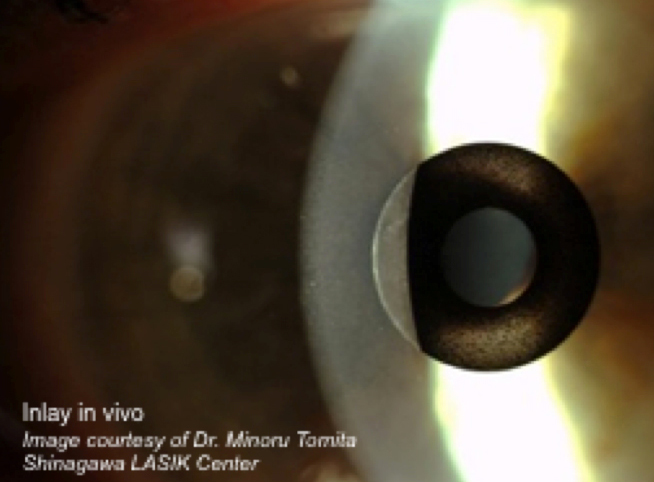Presbyopia is a progressive condition that eventually affects everyone over the age of 40. With many countries already reaching an average population age of 40 or older, presbyopes comprise the fastest-growing segment of the global population.1 Historically, presbyopia has been notoriously difficult to treat. Among the multiple presbyopia treatment options that exist today, most require significant compromise by patients, including reduced intermediate or distance vision. In addition, presbyopia continues to progress as an individual ages, and many of the available treatment options are not long-term solutions.
SMALL-APERTURE INLAY
The Kamra corneal inlay (AcuFocus) is gaining traction internationally as an excellent treatment option for patients with presbyopia. The inlay is unique in the market in a number of ways. First, the Kamra is the only corneal inlay to correct vision using the depth-of-focus principle common to photography: The f-stop on a camera is used to adjust the camera lens aperture, with smaller apertures allowing less light to reach the image sensor, producing a longer depth of focus. The simple and elegant shape of the Kamra inlay allows only focused light rays to reach the retina, providing patients a complete, uninterrupted range of vision. Through application of this principle, the inlay is able to help patients overcome the visual decline associated with presbyopia. Because the inlay has no refractive power, it continues to work naturally, providing patients sustained results even as presbyopia progresses.
EVOLUTIONARY PROGRESSION
The Kamra technology has the longest track record and the greatest amount of implanted corneal inlays for the correction of presbyopia. The inlay is now inserted into a femtosecond laser-created pocket 200 to 250 μm deep and is suitable to treat ametropic, emmetropic, and post-LASIK presbyopes in addition to monofocal pseudophakes.
Regardless of procedure type, patients implanted with the Kamra inlay achieve, on average, J2 for uncorrected near visual acuity, 20/25 for uncorrected intermediate visual acuity, and 20/25 for uncorrected distance visual acuity.2,3 Patients report high rates of satisfaction, and results are stable 5 years out and counting. The data also show that Kamra patients maintain binocular distance vision and have no statistically significant loss of stereopsis.

Kamra inlay design.
DIAGNOSTIC TOOLS
More than 10 years of R&D and clinical experience with Kamra led to the development of the AcuTarget HD, a diagnostic and surgical planning instrument designed to further optimize clinical outcomes and streamline the patient care process. The AcuTarget HD is used preoperatively to assist with patient selection and inlay placement. The device is able to quickly and easily assess the patient’s depth of focus, optical quality, and effect of tear film quality on visual quality as well as identify and correlate key ocular landmarks such as the first Purkinje image and pupil centroid. Postoperatively, the AcuTarget HD assesses targeted versus achieved inlay placement and assists in managing patient care. We know that toric IOLs function best when placed precisely on axis and that when intraoperative devices aid the surgeon in exact placement there are improvements in visual outcomes. Similarly, correct centration of any corneal inlay will provide optimal results. Although the AcuTarget HD was developed with the inlay in mind, the tests performed by the device can be used to assist practices with assessment and management for all refractive and cataract surgery patients.

Kamra inlay in vivo.
PATIENT EDUCATION
Presbyopes can be a difficult group to treat, as they desire perfect vision. Eye care professionals must therefore spend significant time with presbyopic patients, obtaining as much objective information as possible to select an appropriate treatment. The AcuTarget HD enhances patient education, as it can be used not only to identify patients with dry eye but also to demonstrate exactly how the inlay will work. Patients can be shown images reflecting the anticipated postoperative visual quality as well as simple visuals that demonstrate pre- and postoperative depth of focus. This extensive patient education is essential to setting appropriate patient expectations and thus contributes significantly to overall patient satisfaction.
EYE CARE PROVIDER EDUCATION
Corneal inlays are a relatively new concept within refractive care, resulting in the need for both patient and eye care provider education. AcuFocus has designed an extensive clinical onboarding process that covers everything from surgical technique to marketing plans. Resources include online learning modules and live expert guidance. AcuFocus truly forms a team with the eye care provider to ensure successful patient care.
With nearly 20,000 inlays implanted in approximately 50 countries, the Kamra corneal inlay demonstrates superior results with minimal compromises for patients with presbyopia.
1. Central Intelligence Agency. The World Factbook. Available at: www.cia.gov/library/publications/the-world-factbook/fields/2177.html. Accessed May 29, 2014.
2. Carones F. 1-year global registry results for combining LASIK and inlay implantation for correction of ametropic presbyopia. Paper presented at: the American Society of Cataract and Refractive Surgery. April 23, 2013; San Francisco, CA.
3. Tomita M. Treatment of post-LASIK presbyopia with small aperture corneal inlay: 1-year results. Paper presented at: the American Society of Cataract and Refractive Surgery. April 23, 2013; San Francisco, CA.



